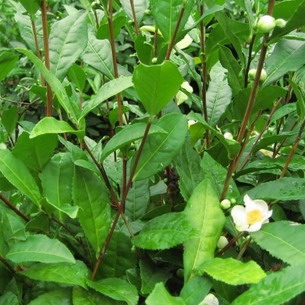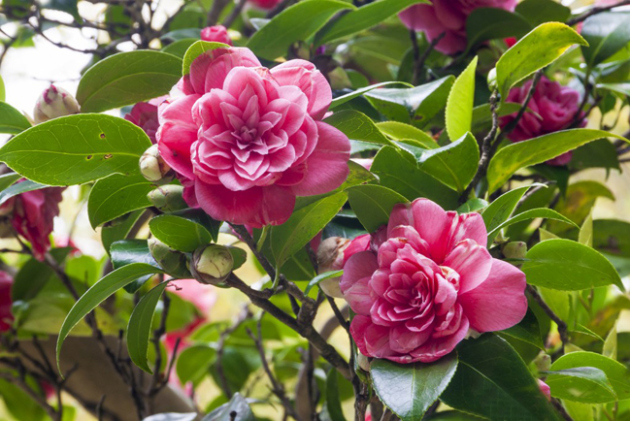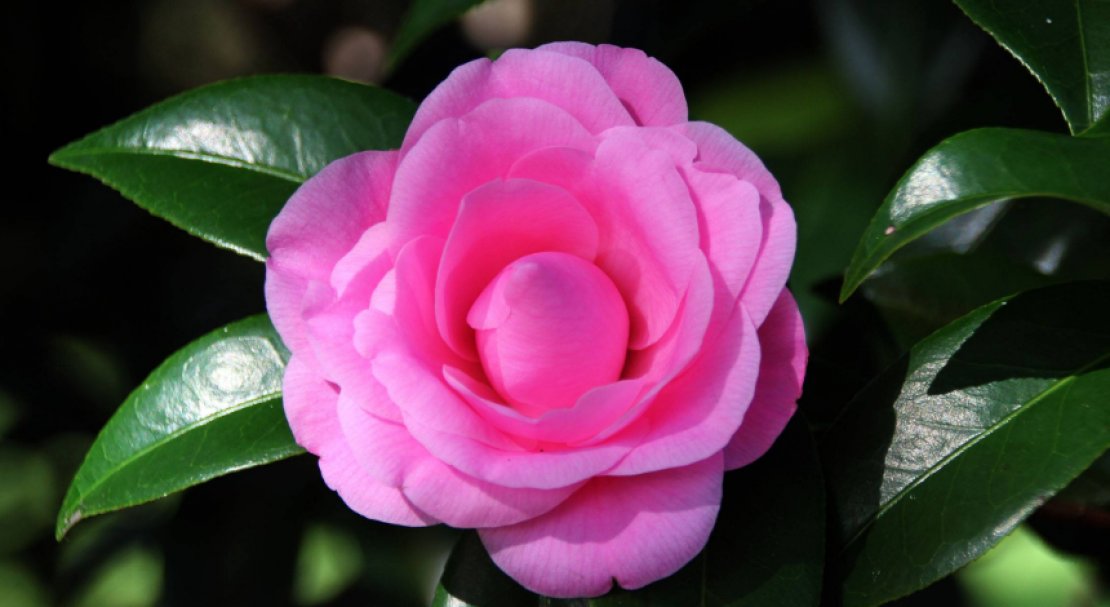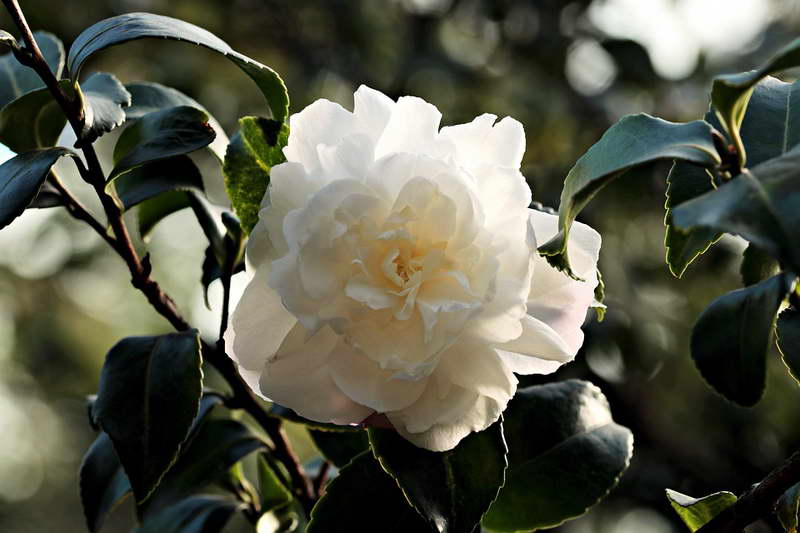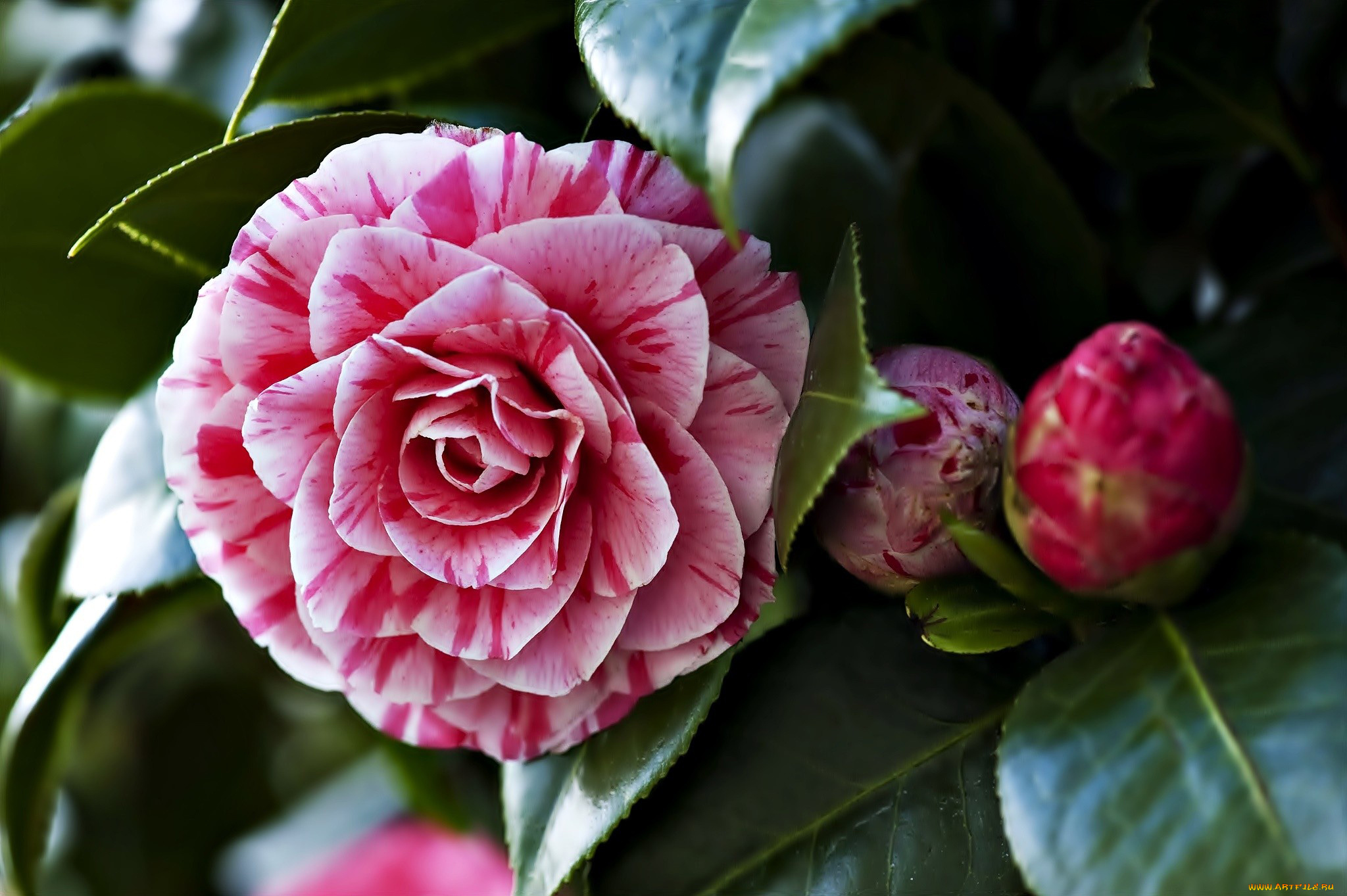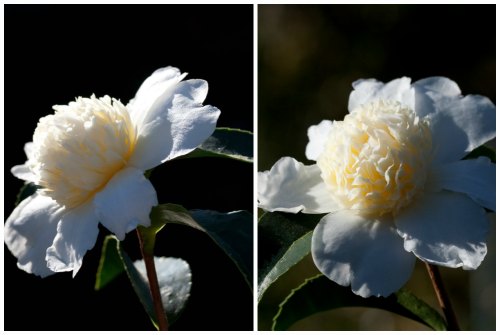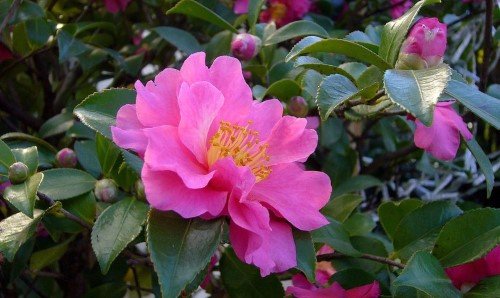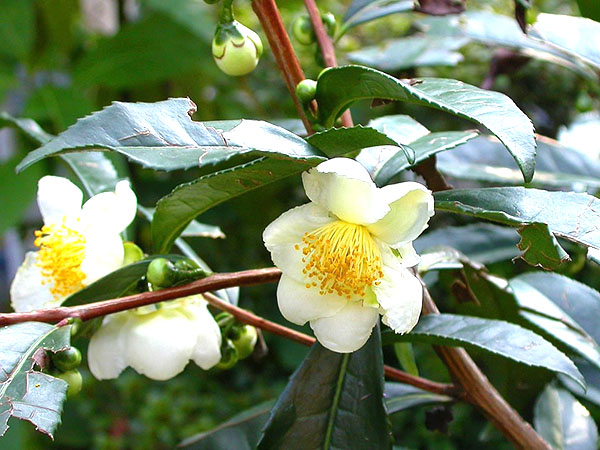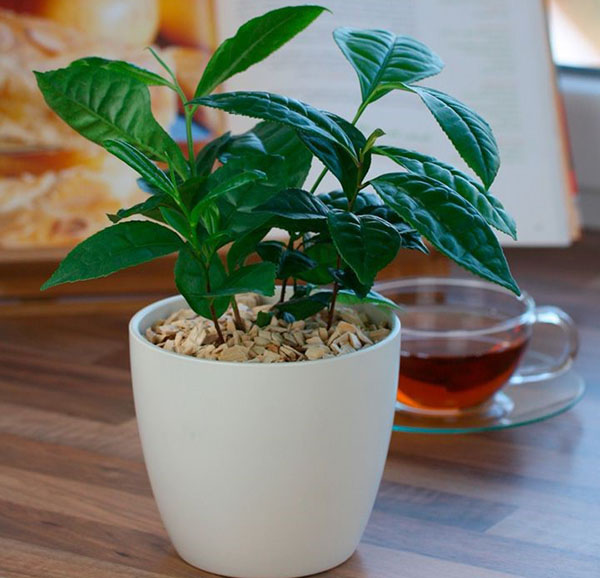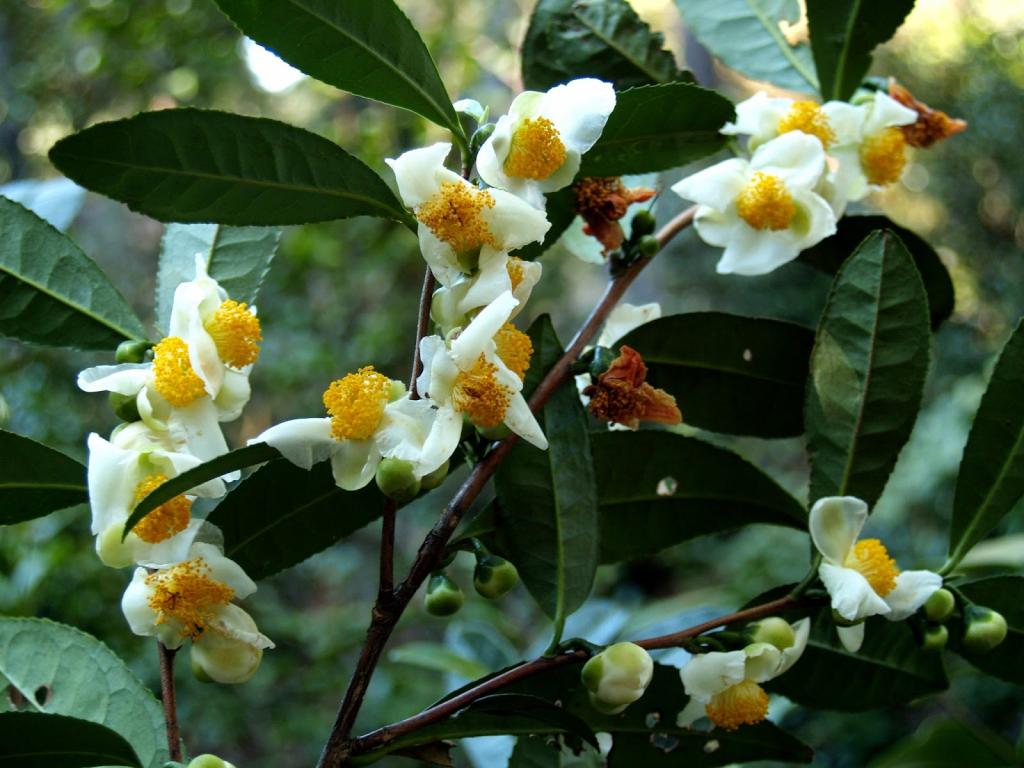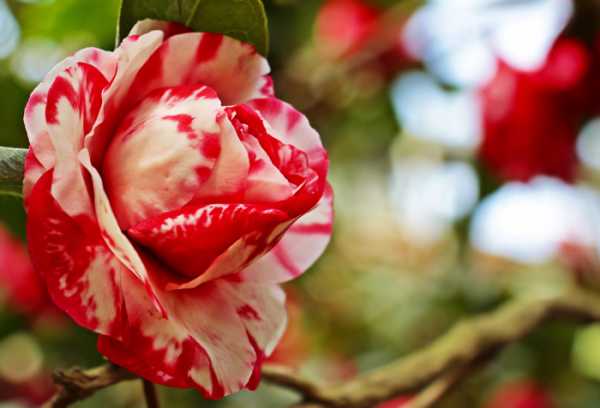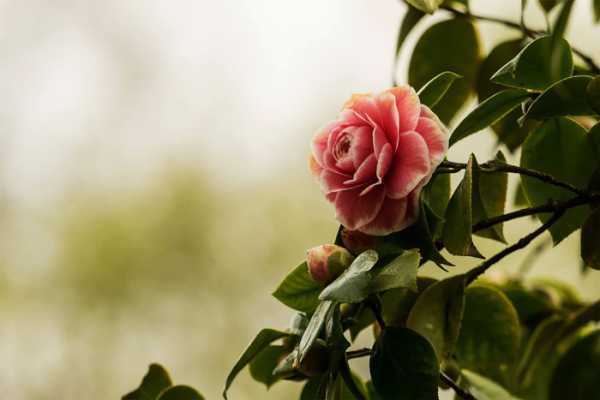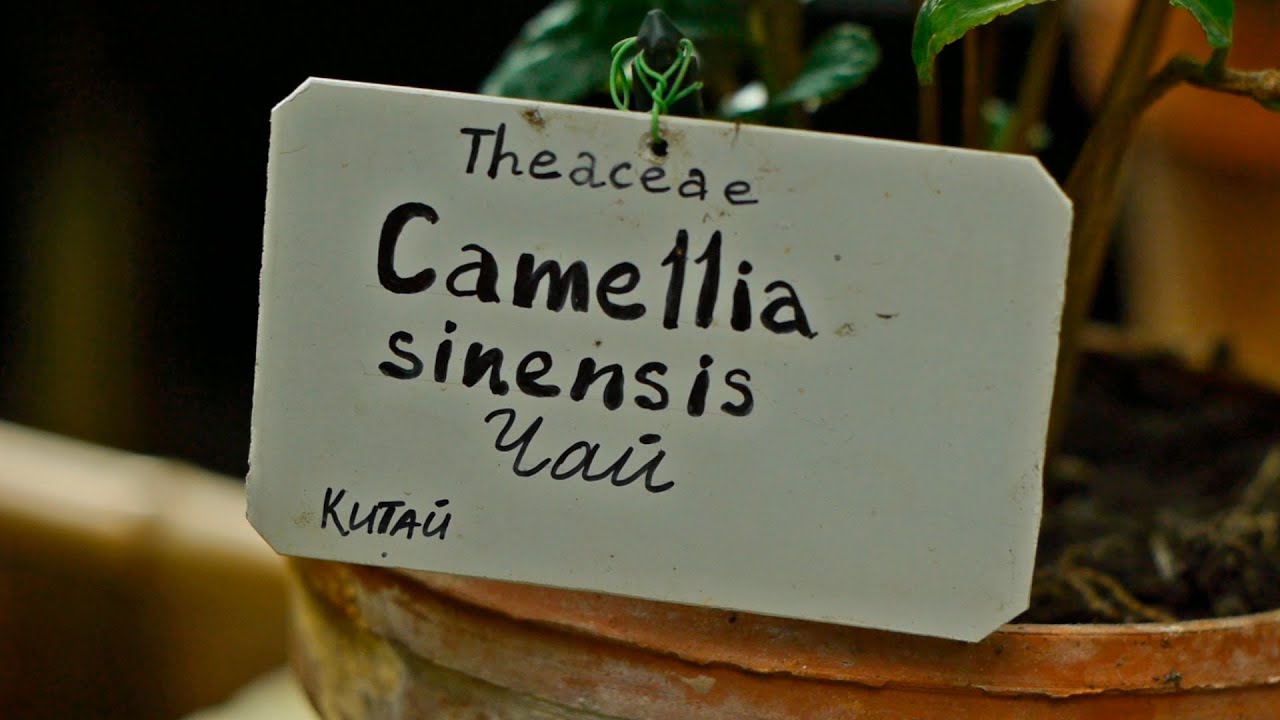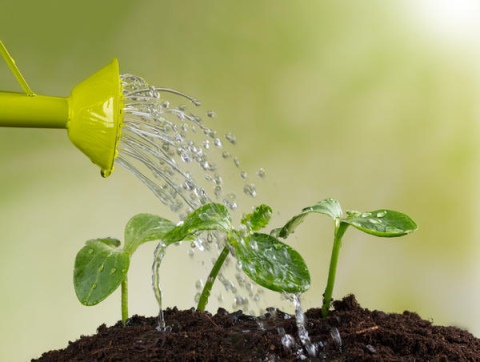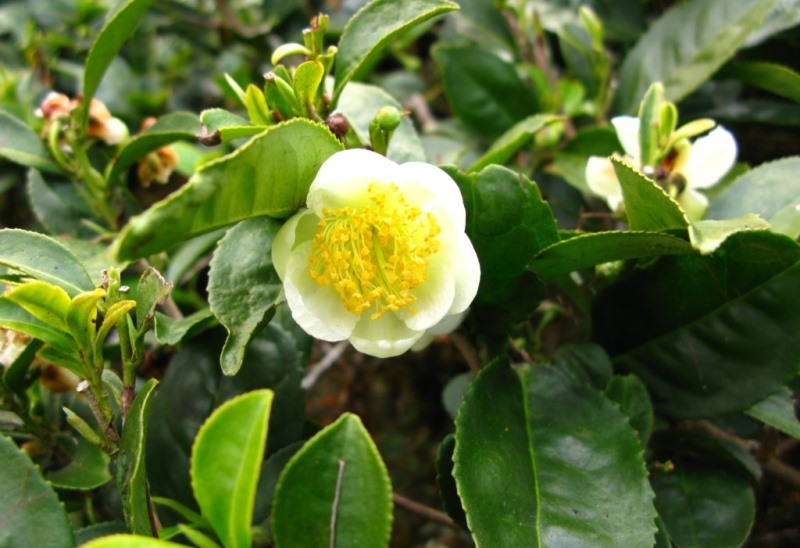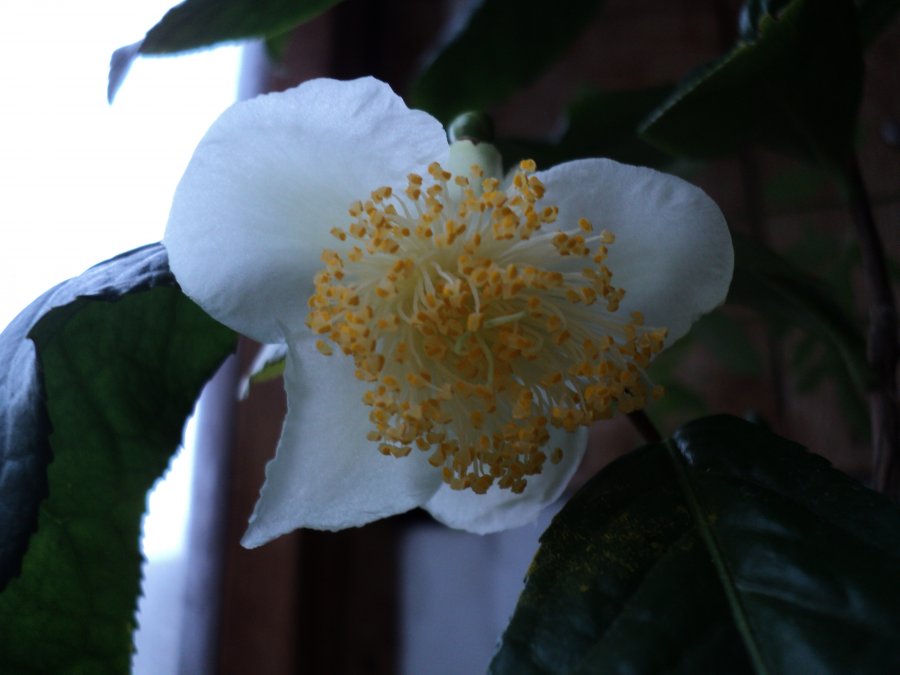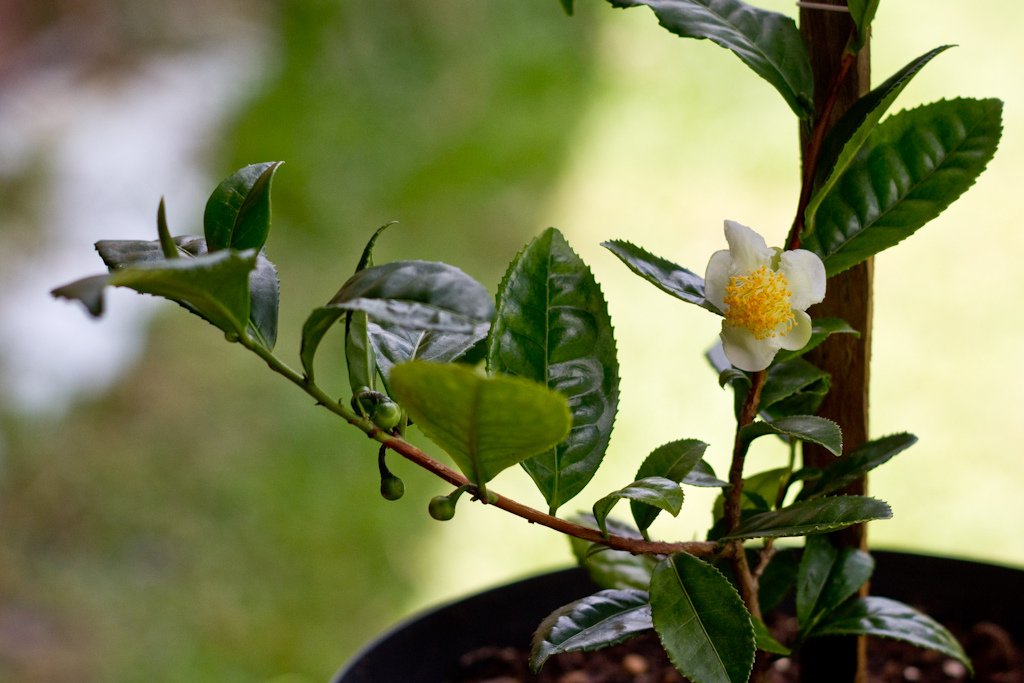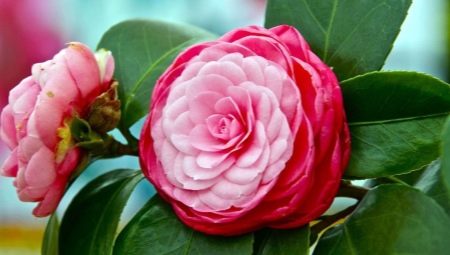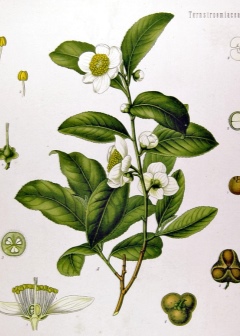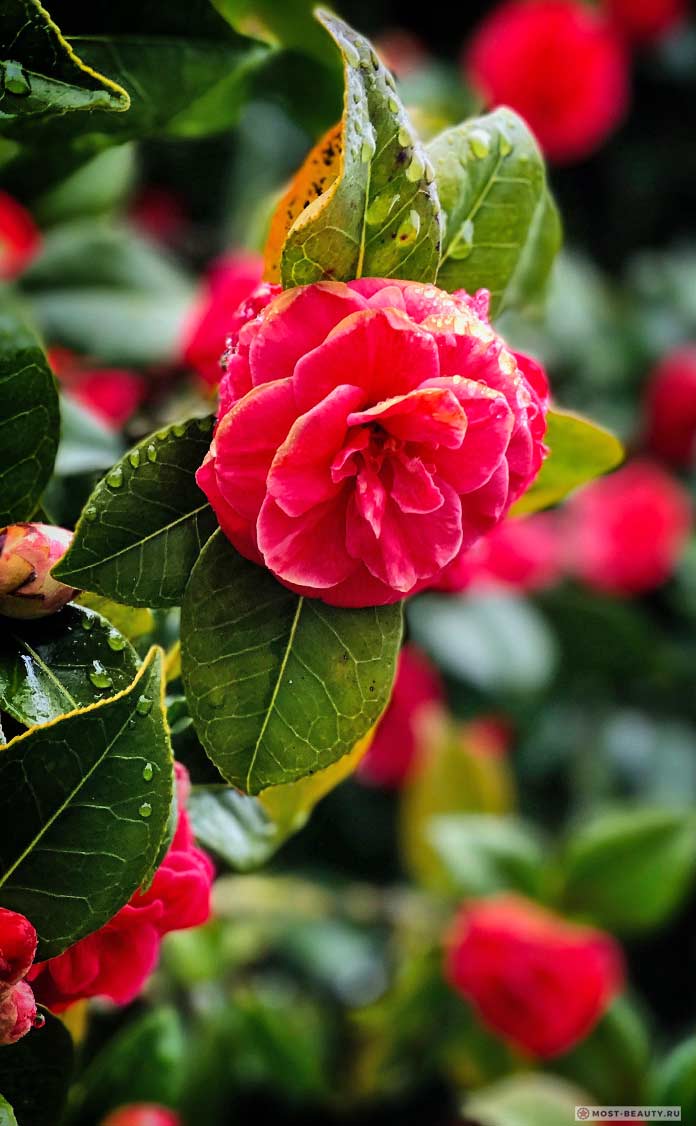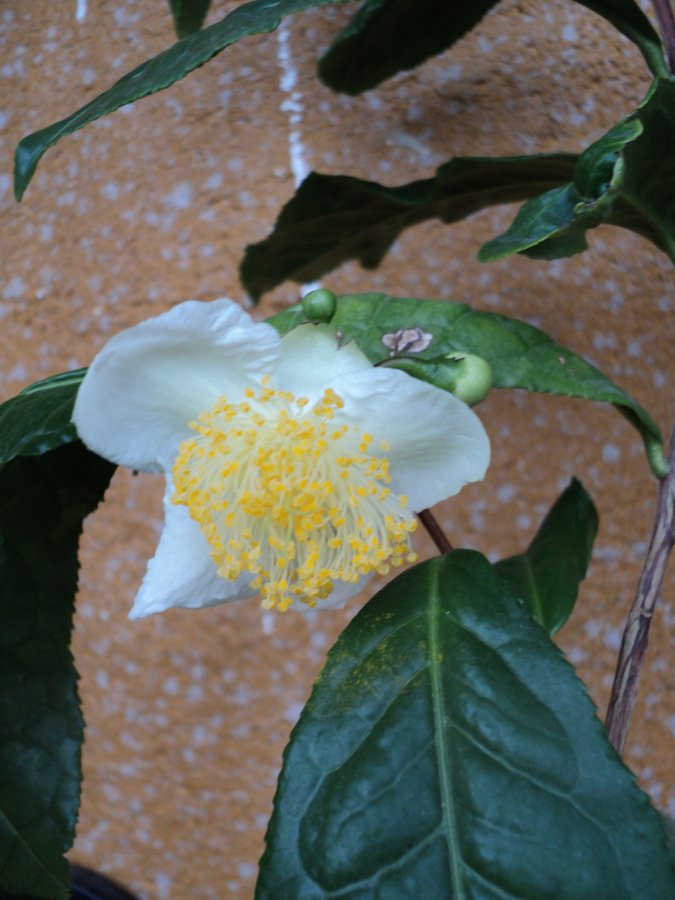Is this an indoor plant?
In warm countries (China, India), Chinese camellia bushes grow outdoors. But what a long way to go - even in warm regions of Russia (such as Sochi) people grow this bush in gardens. In winter, it is sometimes covered with snow, but the camellia steadfastly survives this test. But still, in our area it is better to hide this decorative culture in a house or apartment.
It is a perennial evergreen bush. It grows slowly, but still requires frequent haircuts. If the bush is not started, it will grow in the apartment for more than a dozen years.
The tea bush does not bloom as beautifully as other popular camellias (bush empress, netted, olive, mountain, Williams). Still, the combination of lacquered dark green pointed leaves and small white flowers, decorated with a bright yellow center, looks very pretty. The size of the flower in diameter is only 4 cm. Flowers appear from the axils of the leaves.
If the plant is pollinated, after the petals have faded, the following fruit-boxes will remain:

Large seeds are hidden inside, which will ripen by the end of autumn. They can be planted right away, the babies should germinate.
Do not forget about the benefits of this plant. Many people say that homemade tea made from the leaves of a flowerpot cannot be compared with purchased, even expensive (and I believe them, I tried it myself).
Is it really possible to brew tea from these leaves?
It is worth collecting leaves for a drink from a four-seven-year-old bush or plant older. Picking too early will weaken the bush, making it grow fewer new shoots.
No scissors - you need to work with your bare hands, carefully pinching off the shoots and leaves you need.
Select the youngest apical shoots with 2-3 leaves. Separate them from the bush and rub lightly in your hands to make them sticky (essential oil will begin to stand out from the leaves). In this case, the leaves will begin to curl characteristically.
Dry the tea on the table by spreading them out on a baking sheet (so that dust particles do not fall on sticky leaves, they should be protected with kitchen wrap). Then send the baking sheet to the oven and slightly dry the tea there, setting the medium temperature. Instead of an oven, if there is space, you can dry the leaves in the shade from 12 hours to a day. As you might guess, after simple drying we get green tea, and after the oven - black.
Put the finished tea in a metal or glass jar with a tight lid. If the jar is transparent, keep it in a closed kitchen cabinet out of the sun.
Having brewed such a drink, you will notice that it is not as strong as the purchased one. But then there is no doubt: there is more benefit in it, but there is not a single gram of chemistry.
Personally, I like to mix homemade tea with dried strawberries, cornflower petals (I collect outside the city), mint, apple pieces, and in winter - citrus zest.
The only thing: there is barely enough tea from one flowerpot for home gatherings. There is no longer any money left for gifts for friends and relatives ...
But if friends come to visit, you can pick off a few upper (slightly pubescent on the seamy side) leaves from the bush and boil them with boiling water, throwing 2-3 fresh leaves on the glass. You too will make a tea that is astringent, bitter and invigorating.
Botanical Description of the Tea Bush (Chinese Camellia)
Chinese camellia is similar in appearance to tea plants, of which there are more than 200 species, but the bush has its own distinctive features. Camellia was formed in Yunnan more than 70 thousand years ago. The family has two botanical subspecies:
- Actually Chinese, sinensis sinensis;
- Assamese (by state in India).
Subspecies have their own characteristics, but they can interbreed with each other.Sinensis is a shrub, it is low and has small leaves. Shrub description:
- the leaves are elliptical with pointed jagged edges;
- foliage color - dark green;
- the touch of the sheet is similar to the skin;
- length of the sheet plate - 7 cm;
- width - 4 cm.

The color of greenery changes gradually, young leaves are pale, then begin to darken. Camellia flowers are modest and less vibrant than the Japanese species. They are formed in pairs. Corollas are white or slightly pink, the middle protrudes in the center. At the place of the ovary, a box is formed, in which there are 3 valves. The seeds are large, ripen slowly and closer to winter.
In the first year, the bush grows up to 30 cm. Then it becomes lower, diverges in volume.
Flowering begins in the second year. Abundant flowering occurs in cool periods:
- late fall;
- winter;
- early spring.
The shape and appearance are similar to roses. Harvesting tea leaves is recommended after 5 years. The plant is long-lived, it can become a friend to the owner for several decades.
Chinese camellia: what is needed for flowering
Hello dear readers! How do you look at planting a Chinese camellia? The plant will bring many benefits.
Chinese camellia is a bright representative of evergreen shrubs. At home, in India and China, these plants adorn streets, courtyards, and grow by themselves. The shrub is not in demand as an ornamental crop; locals prefer flowering plant varieties.
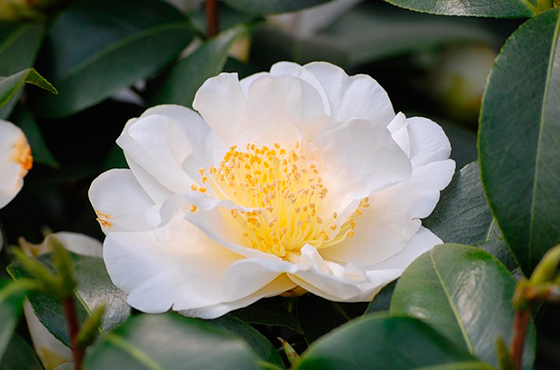
And this variety is called a tea bush in another way. Raw materials are used for the manufacture of drinks, used in cosmetics.
We rarely meet such flowers. Nevertheless, Chinese camellia is in demand by experienced flower growers who are fluent in the peculiarities of caring for it. Maybe you and I will grow it and brew fragrant tea?
All camellias are capricious, but this cannot be said about the Chinese. The plant will pleasantly surprise you with its rapid growth, provided you follow simple recommendations.
Watering and air humidity
Drying out of the substrate in which the decorative tea is grown is inadmissible. Watering the plants is carried out as the top layer of the soil dries up. You will have to refrain from abundant watering; they should be replaced with more frequent, but moderate ones. If you overdo it with soil moisture, the plant will slow down its growth. Stagnant water can also cause root rot. If we talk about drought, then it is not so insidious, but it is advisable to avoid it, because it can negatively affect the quality of the leaves and lead to their falling off.
During the formation of buds and flowering, watering should be reduced, but at the same time you will have to make sure that the soil does not dry out. Caring for an ornamental plant involves loosening the soil. It is necessary to carry out such a manipulation after every fifth watering. The top layer of the substrate must be fluffed so as not to touch the roots. As for the humidity of the air, it is extremely important for the plant. Do not place pots near heating devices, air conditioners. Tea feels good indoors, where the air humidity ranges from 65-75%.
It is necessary to increase the humidity indicators only during the wintering period. At this time, the bushes must be sprayed regularly. It is advisable to install humidifiers near them.
Pallets or bowls with wet pebbles and expanded clay can be placed under the pots. Watering and spraying should be done with high quality soft water that has been purified.
Description and varieties
Camellia (lat. Camellia) belongs to the teahouse genus and includes almost 80 species of plants. It grows in the tropical and subtropical zones of Southeast and East Asia, in Japan and Korea, on the Indochina Peninsula, on the Philippine Islands and about. Java. Camellia was brought to Europe for the first time from the Philippines by the priest and naturalist Camelius G.I., in whose honor the plant acquired this name.
Camellia are small evergreen trees or shrubs.Simple leaves are ovoid or elliptical, leathery to the touch, shiny; are both blunt and pointed, grow in two or three pieces, or singly. Petals with a large number of stamens are pure red, pink, or white, and sometimes they are multicolored.
Certain types of camellia are valued for their decorating qualities - both for their beautiful leaves and flowers. When breeding camellia indoors, it not only grows well and blooms, but can also bear fruit - for this it is necessary to provide it with proper care. Young growers often fail to cultivate camellia due to mistakes in care - low lighting, improper soil mixture, too hot air or low moisture. By following the rules outlined in the article below, you can grow a healthy and beautiful plant.
Main varieties
More than two hundred species of camellias are known, however, they all stem from four main varieties: Japanese camellia (C. japonica), mountain (C. sasanqua), saluenian (C. saluenensis) and reticulated (C. reticulata).
The most famous types of camellia:
Mountain camellia (Camellia sasanqua). Either the camellia tegmentosa (Camellia tegmentosa) or the camellia Miyagii (Camellia miyagii) - in nature, this species is found on the islands of Kyushu and Okinawa. These shrubs are quite tall, so they can reach a height of 3-5 meters. On the surface of the stems there is pubescence in the form of reddish hairs, and the branches of this plant are very thin. The leaves are elliptical or elongated-ovoid, up to seven centimeters long and up to three centimeters wide. Their edges are serrated, the shiny front side is painted in a dark emerald color, from the seamy side, the middle vein is pubescent. Simple fragrant flowers can be up to seven centimeters in diameter. They can be both single and grow in two or three pieces. The flowers are pigmented in pink, red or white. Rich flowering is observed in November-January. These plants love coolness.
Chinese Camellia (Camellia sinensis). Or camellia bohea (Camellia bohea) - naturally found in the forests of China and love to grow on mountain slopes or in gorges. This species is represented by both shrubs and trees, reaching a height of 15 meters. The leaves are elliptical or oval in shape and grow up to ten centimeters long and up to four centimeters wide. Glossy leaves are painted in a dark emerald color. Young leaves have a pubescence of whitish hairs, and old leaves are bare. The axillary flowers are snow-white and have rather short pedicels. They grow singly or 2-3 pieces.
Japanese camellia (Camellia japonica). Under natural conditions, this species is found in the forests of China, Japan and Korea. These shrubs or trees can be up to 15 meters high. Shiny, leathery, dark green leaves have denticles along the edge and are pointed at the apex. Their shape is elliptical or ovoid, and the leaves grow up to ten centimeters in length. Simple flowers are up to 4 centimeters in diameter and can grow separately or in several pieces. The flowers are semi-double and double, and they are pigmented in a pink, red or white color shade, as well as a variegated color. Blooms from December to April.
Collection and processing of tea leaves
Collecting tea leaves is the most important, laborious, stressful and responsible period. On farms, it lasts more than 5 months. A large proportion of the tea leaves are still harvested by hand or by hand-held tea picking machines.
The first collection of the leaves of the tea bush should be carried out after the second shaping pruning, when the plants reach 4 years of age, and the height of the bushes before the start of harvesting the tea leaves will be at least 35–40 cm. The leaves are harvested selectively, only from those shoots that have come to harvest.Early harvest weakens the bushes and leads to a decrease in yield, while selective picking promotes shoot growth and serves as the basis for a high yield of good quality. Collection of green tea leaves in apartments is carried out from May to September from five-leaf shoots.
As shown in the photo, apical shoots with two or three delicate leaves and a bud are torn from the tea bush:
From a 3-4 year old tea bush, you can already collect some green leaves and enjoy your own tea. At home, everyone can brew it themselves to their liking, in terms of quality it will be no worse than that obtained from a tea factory.
Leaf processing technology includes the following processes: withering, rolling, fermentation and drying. At home, the collected shoots wither in the room for 12-18 hours (but 5-7 hours is possible): the leaves are scattered on a board in a thin layer (1.5-2.5 cm) and kept in the shade until they will not lose their elasticity and will not become soft. After that, the tea leaves are rolled between the palms until they curl up into tubes and a small amount of white foam appears on their surface.
This is a sign that the cells of the tea leaf are crushed and the cell sap has come into contact with air and enzymes. Then the leaf is laid in a layer of 10–12 cm, covered with a damp towel and kept for 4–5 hours at a temperature of 20–23 ° C, leaving to ferment (fermentation). The fermentation process is considered final when the leaf acquires a copper-red hue and a characteristic tea smell. Once fermentation is complete, the leaf is immediately dried in the sun or in an oven at 90–95 ° C. After drying, a finished black tea is obtained.
Home care for Camellia Sinensis
Having your own tea bush at home is the dream of many flower growers. But camellia is a rather demanding plant, therefore, for its successful cultivation, you need to know all the intricacies of care.
Lighting, temperature and humidity
When growing camellia, direct sunlight should be avoided; for this, a place with diffused light is chosen, for example, a southwest window. It is advisable for the plant to extend the daylight hours to 14 hours, this is difficult to achieve in the autumn-winter period, but additional lighting solves this problem.
For a plant, a comfortable summer temperature is + 25 ° C, optimal in winter - up to + 15 ° C. During flowering, it is impossible for the thermometer to rise above + 15 ° C, since the flower will drop its buds. If the temperature drops below + 10 ° C, then this threatens the death of the bush.
It is also important to control the humidity in the room where the camellia is located. Spraying is recommended several times a week, more often at temperatures above + 25 ° C
In winter, with dry air, the bush is sprayed once a week without watering. To maintain the required humidity level, you can keep wet expanded clay, pebbles or moss nearby.
Watering, feeding, soil
Excess calcium is harmful to the flower, so only soft water at room temperature is used for watering. Rain or thawed water is ideal, but running water that has been left for several days is also a good option. The soil should not be allowed to dry out, it should always be wet, watering abundant, but the water from the pan must be drained to avoid root rot.

During the growth period, feeding is done every two weeks.
Fertilizer for camellias works well for azaleas, but the amount in the instructions should be halved.
When choosing a fertilizer, you should always pay attention to the composition, since the presence of calcium or magnesium can lead to dropping of the buds. In autumn and winter, the plant is not fertilized so as not to provoke the growth of new shoots.
The flower thrives in acidified, loose soil, rich in fertilizers. To determine the pH of the soil, indicator litmus paper is used. You can buy ready-made soil for azaleas, camellias or rhododendrons.Or prepare the soil mixture yourself, taking one part of the leaf, peat, coniferous soil and adding half a part of the sand.
Flowering care and pruning
When the camellia has bloomed, then watering is reduced and carried out only under the root, and spraying also stops, since water ingress on the flowers can lead to stagnation of liquid and rot. In order not to provoke the reset of the buds, it is not recommended to move, rotate or rearrange the pot. Pruning is used to remove weak shoots, activate new ones, or shape the flower. It is carried out after flowering is complete.

Shoots are cut to ½ the length and then treated with garden var.
Preparing for winter
For many plants, winter is a dormant period when they shed their leaves and recover from flowering. But the amazing camellia begins to bloom in winter, so you need to prepare in advance for this process. First of all, a place for wintering plants is determined. It should be away from radiators, with a temperature of about + 15 ° C.
Choosing a place in advance is important because when flowering begins, you cannot move or carry the pot, so as not to provoke the buds to fall off. In winter, watering is reduced as the soil dries out more slowly. The next watering should be carried out only when the top layer of the earth is slightly dry. Fertilizers should not be applied to the soil in winter.
It will also be interesting: Hibiscus (Chinese rose) - home care for an indoor flower?
Growing indoors
Home-grown camellia is different
relatively high care requirements. For long flowering and
growth within the normal range of the tree should be provided with optimal conditions.
Lighting
Camellia is a light-loving culture. For her you should choose
a well-lit place, but the light must always be diffused.
In order for the crown to form evenly, the pot must be regularly rotated around its axis. However, it is possible to disturb the bush only during the dormant period, and it is extremely undesirable to do this during the formation of buds, since they can fly around and the plant will not bloom.
We recommend reading: only 3-4 dressings per season and a rich harvest are provided for you ...
In the warm season, the bush can be transferred to fresh air. V
In this case, a place is chosen for him that is reliably protected from scorching
rays of the midday sun.
Temperature regime
During the budding period, which usually occurs
for the summer months, the optimum air temperature for this plant is from 20
up to 25 degrees. During the ripening of the buds, the tree is transferred to more
cool place - from 15 to 18 degrees. During the flowering period, camellia should
be sure to be cool (from 8 to 12 degrees), since it is warm
can throw off the buds.
Watering and humidity
This culture prefers to grow in high humidity.
air (about 90 percent). On hot summer days, it can drop to 75
percent. At any time of the year, the bush should be regularly moistened from
sprayer, and make sure that no droplets of moisture fall on the surface
buds. An open vessel with water can be placed near the bush.
Special attention should be paid to watering home camellia.
To do this, use only well-settled water, the temperature of which
should be slightly higher than room temperature. Avoid stagnation of moisture in the roots
V
the period January-May it is necessary to water the tree systematically, using for this
a large amount of water. Then the frequency and abundance of watering is gradually reduced,
however, the earthen lump should not dry out. At the end of summertime again
carry out a gradual increase in watering.
Suitable substrate
A soil mixture suitable for growing camellia should be
acidic, friable, and it is also good for water and air to pass through. If desired in
specialty store you can buy ready-made substrate for azaleas or
rhododendrons.
If desired, you can prepare the substrate yourself. For
this sand is mixed with perlite. When planting in such a substrate, the plant needs
water every day. To reduce the amount of watering, add more
add peat and vermiculite.
The size of the pot is chosen taking into account what is needed at its bottom
make a drainage layer, the thickness of which should be about 50 mm. To do this, you can
use gravel or coarse sand. However, before filling the drain
to the bottom of the pot, be sure to combine it with a small amount of soil mixture.
Transfer
A transplant of this evergreen is recommended
spend 1 time in 2 or 3 years. At the same time, it is transplanted in the winter, and not in the spring.
You can carry out this procedure during flowering. Be very careful to
do not injure the root system, as this can lead to the death of the bush.
It is recommended to transplant camellia using the transshipment method.
Before removing the bush from the pot, the substrate is abundantly moistened. Try
so that the earthen lump does not fall apart during transplantation.
Fertilizer
Top dressing of this plant is carried out only during the growing season.
You need to start feeding him in the last days of winter or the first - in spring. V
July, all feeding should be stopped.
You need to make top dressing on time, while it is imperative
use the dosage recommended by the manufacturer (see
packaging). Fertilizer of the following composition is suitable for camellia: zinc, potassium,
nitrogen, sulfur and phosphorus. Moreover, it should not contain magnesium and calcium. Feed
the plant cannot be dung.

Pruning
Cut the bush after it has faded, and it should
to be at rest. Cut out all twisted, withered and
injured stems. The cut is made at an angle of 45 degrees directly above
leaf knot. To activate the axillary buds from mid-October to the end
November, you can pinch the tops of the stems.
Bloom
As a rule, flowering occurs in the winter. Some varieties
flowers open at the end of November. A lot of buds are formed on the stems.
Therefore, in order for the flowers to be larger, and the flowering to last longer, it is necessary
remove extra buds, leaving a maximum of two on each shoot.
Reproduction, planting and transplanting of Tea Camellia
Reproduction of camellia is carried out by seeds, cuttings, layering and grafting. However, it should be remembered that seeds quickly lose their germination, and at home, camellia rarely gives them. Sowing material is purchased in greenhouses or flower shops, which does not guarantee germination. Therefore, flower growers most often use the grafting method.
Cuttings
When grafting, it is important to fulfill several conditions:
- For reproduction, a semi-lignified camellia stalk is selected.
- It is olive in color and differs from young green shoots, which are not suitable for planting.
- Leaves must be present on the handle.
- One side of the cutting is dipped in phytohormone and planted at a slight angle in sand, which can be mixed with peat soil in equal proportions.
- In order for rooting, which lasts two months, to go well, the soil should be heated from below to ensure a temperature of + 25 ° C.
- Until complete rooting, it is advisable to cover the cutting under a film, periodically airing it.

Despite the long process, cuttings ensure the safety of the variety, and the young plant will be the same as the maternal plant, which may not happen during seed propagation.
Seeds
If the florist decided on a difficult method, then the seed reproduction algorithm is as follows:
- First of all, you need to check the germination of camellia seeds. To do this, all the seed is placed in water and the seeds that have floated are removed (they are not suitable for sowing).
- The next step is to soak the seeds. They are kept in water at room temperature for about two days.
- After soaking, the seeds are immediately placed in a moistened mixture of coniferous soil, peat and sand.
- Planting depth is no more than five centimeters.
- The container is covered with foil and the temperature is maintained at + 25 ° C.
- The film is periodically removed for a short while for airing.
- The first shoots will appear in 2.5-3 months, but it will be possible to plant them in individual containers only after several full-fledged leaves on the shoots have opened.
Landing, transplanting
To plant camellia, it is necessary to prepare a wide, shallow pot, on the bottom of which a drainage layer should be poured, and then a layer of soil. When planting, you should monitor the root collar, it should be above ground level. Before the planting procedure, you need to disinfect the entire tool and it is advisable to check the soil for acidity, the pH value should be in the range of 4.5-5.
Transplantation is carried out annually only for young plants, later for adults once every 2-3 years is enough. The transplant process itself is carried out in the winter after flowering. If the acidity of the soil is insufficient, it should be mulched with pieces of bark or sawdust.
It will also be interesting: Clerodendrum Ugandan - caring for a plant at home?
Growing camellia from seeds
An important point! The real shelf life of the seeds of this culture is several months. Therefore, when choosing planting material in the store, carefully study the packaging. If the seeds lie for a year or more, they are unlikely to germinate.

There is an opinion that it is better to order such seeds from foreign sites (for example, from Aliexpress), from sellers with a good reputation. Chinese camellia seeds are sold there all the time, but remember that they ripen in November. Therefore, it is better to order from the end of November to December.
Soak the seeds in water. Some will come up. This does not mean that they are "empty", but still these light seeds will have a relatively poor germination capacity. The seeds should stay in water for 2 days. To get them all well wet, press them down with a weight. Change the water every day.
Plant the seeds in moist soil, deepening them 4-5 cm. A good soil option: sand + deciduous soil + peat. Also, do not forget that there must be drainage at the bottom of the container (pot).
Germinate the seeds under the foil, at a temperature of about 23 degrees. Lift the film for 5-10 minutes every day to ventilate the soil. And if you see that it is dry, water the seeds.
You should see the seedlings in 30-45 days. Noticing that all the seeds have hatched, you can remove the film.
Pick time - each baby has 2 real leaves
In this case, it is important not to deepen the root collars of the seedlings - they should be strictly on the ground line.
Caring for yesterday's seedlings: regular watering, gentle loosening of the soil, top dressing.

A tea bush grown from seeds will bloom in 1.5 years. But at the same time, it will be very miniature, since in the first year of life in a separate pot, the plant will grow a maximum of 30 cm, and then it will grow even more slowly. More or less camellia will take shape by the age of 7-8.
Caring for a flower growing on a windowsill
Lighting. It should be good, but without direct sunlight (the west or east window is out of competition). At the same time, choose a corner for the camellia well. The fact is that during flowering, this plant hates permutations and even simple turns of the pot.
Room temperature. In summer, the plant needs warmth - from 20 to 25 degrees, and the pot can stand both in the room and on the open balcony or in the garden (camellia is not afraid of rain). And from autumn to spring, camellia requires truly Spartan conditions - about 15 degrees.
Humidity. The tea bush prefers moderate humidity. That is, it can be sprayed, but not every day - three times a week will be enough. Always boil water.
Watering. Look at the condition of the soil - it should always be slightly moistened
It is very important that the water is soft. Worst case, just stand up for it
It is even better to collect rainwater for camellia or use heated thawed water. An interesting point: if other flowerpots consume a lot of water during flowering, then camellia, on the contrary, from the beginning of the budding period, you need to water a little less than before.
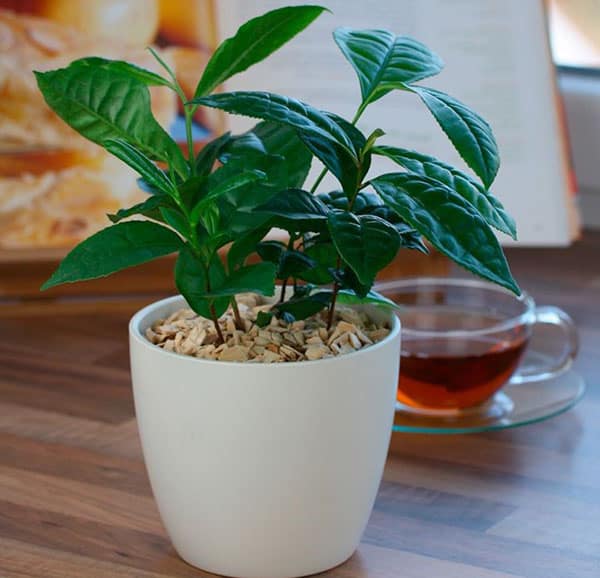
- Nutrition. The flower likes both organic matter and mineral fertilizers. You can give them to him in spring and summer - it is during these seasons that the plant begins a period of intensive vegetation.
- Pruning. A mandatory procedure for this culture. It is held at the end of August. The resulting apical branches can not be thrown away. If you stick them in a glass of water or light soil and hold them under the bag, the twigs should sprout.
More practical advice on growing camellias of any type and variety will be given in this video by a garden expert:
Transfer
This is a little unexpected, but: the camellia is transplanted during flowering, in winter.
Young bushes are disturbed with such a procedure once a year, "middle peasants" - once every two, old plants - once every three years.
Take the soil for an adult tea bush a little sour, increased friability. Personally, I think forest land is ideal. Moreover, you need to collect it not in a deciduous forest, but in a spruce (pine) forest. The presence of needles and pieces of bark in the soil is only a plus.
However, you can buy ready-made soil mixture for azaleas, it will also suit the flower. And so that it does not seem too heavy to the tea bush, it should be "fluffed" with the addition of sand and sphagnum.
Always choose a pot with bottom holes and a tray. Water in the latter should not linger - everything that is poured into the pan during watering, immediately drain.
At the end of the transplant, you can mulch the bush with chopped and well-steamed needles or pieces of pine bark.

